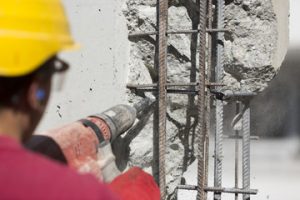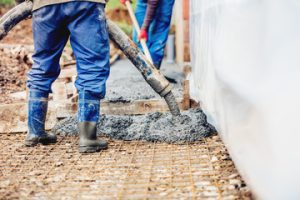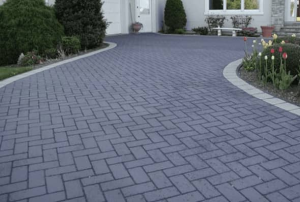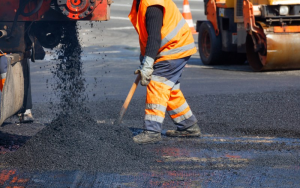Concrete Franklin TN is one of the world’s most common building materials. It’s a blend of aggregates (usually natural sand and gravel or crushed rock) bound with a hydraulic binder.

This binding is what makes it possible to create such a versatile and powerful construction material. But even a small change in the ingredients can make the difference between a good concrete and a bad one.
Concrete has an incredible strength that makes it ideal for building load-bearing structures. Unlike wood or asphalt, it can withstand the pressure of heavy loads, and it can also resist compression and bending. Concrete can also last for years if it is properly maintained and protected. This is one of the reasons that it is used for long-lasting infrastructure such as roads and bridges.
The strength of concrete depends on the way it is mixed, the proportions of its ingredients and how it is poured. The mixture must be well-proportioned so that it is easy to work with and strong when hardened. A well-proportioned mix is characterized by low air entrainment and a high sand to cement ratio. In addition, the concrete must be poured carefully in order to avoid air pockets and other imperfections.
This process is called hydration, and it begins directly after the mixing of the ingredients. The hydration reaction is an exothermic process that adds strength to the concrete, making it a very durable material. However, this strength can be compromised by the wrong water to cement ratio or improper curing.
Another factor that affects the strength of concrete is its ability to withstand tensile forces. For this reason, it is often reinforced with steel or other materials. Reinforced concrete has a much greater capacity to withstand bending and twisting forces than unreinforced concrete.
The quality of concrete is usually rated by its compressive strength, which can be measured using the characteristic cylinder test. The higher the characteristic cylinder strength, the stronger the concrete. It is important to note that concrete has a tendency to crack, especially during the initial stages of its development. The best way to prevent cracking is by using concrete reinforcement.
Besides its compressive strength, concrete has excellent durability and resistance to corrosion. It can withstand extreme weather conditions, heavy loads, and wear and tear over time. It can also be molded to create shapes that are impossible with other construction materials, such as stone and metal.
Concrete is made by combining fine and coarse aggregates with Portland cement. The concrete mixture is then poured into a form and allowed to set. During the curing phase, the concrete must be protected from sunlight and wind that accelerate the chemical reaction. Ideally, the concrete should be left to cure for twenty-eight days before it can achieve its intended strength.
Durability
Concrete is a versatile construction material that is used in a variety of applications. Whether it’s poured for sidewalk forms, high-rise walls, foundation footings, or underground trenches, its strength and durability make it a great choice for a variety of structures. It also resists environmental conditions and fire, making it an ideal protective layer for steel structures. In addition, it can be molded into complex shapes and can be aesthetically enhanced with different colors and textures. Its compressive strength makes it an excellent choice for paving major roads and highways, commercial parking lots, sidewalks, and dams. It also stands up well to freezing temperatures, heavy traffic, and deicing chemicals.
Achieving the intended strength of concrete requires proper curing, which involves keeping it damp while the cement hydrates. If the concrete dries too quickly, it will experience unequal tensile stresses and crack easily. To prevent this, the concrete is usually kept moist for some time after it’s poured. It is also protected from the elements, which can accelerate the curing process.
Modern concrete mixtures are typically composed of aggregates and a paste, with the former consisting of sand, gravel, crushed stone, or other natural materials. The latter contains cement, which binds the aggregates together and forms the concrete matrix. The size of the aggregates and their relative proportions determine the quality of concrete produced, with a higher percentage of finer materials producing weaker concrete. Alternatively, specialized concrete mixes can be formulated to achieve desired properties by using various cement replacements. These include pulverized fuel ash (PFA) and ground granulated furnace slag (GGBS). These materials are partially recycled industrial waste products, which help to reduce the use of non-renewable resources.
Unlike other building materials, which require energy-intensive production processes and extensive upkeep, concrete is relatively easy to produce, transport, and mix. It also has a lower carbon footprint than steel, as it is more durable and requires less energy to upkeep. Moreover, it requires lower temperatures to harden, which reduces greenhouse gas emissions. Moreover, the material is relatively inexpensive and can be shaped to suit specific needs, making it an ideal option for sustainable construction.
Aesthetics
Concrete is so ubiquitous in the urban landscape that we rarely consider its aesthetics. However, this versatile material offers a wide range of design possibilities and can be used for both decorative and architectural purposes. Concrete can be stamped, stained, and polished to achieve a variety of different designs and finishes. It can also be mixed with other materials such as pebbles or glass to create unique textures and designs. In addition, concrete can be formed into complex shapes and structures to add visual interest to a building.
The most popular use of concrete is in the construction of poured walls, which are a common element in modern architecture. Poured walls offer many advantages over block walls, including durability and longevity. They can withstand heavy loads and are highly resistant to the elements, including extreme temperatures and rain. In addition, poured walls can be reinforced with rebar to increase their strength.
Although poured walls are typically gray in color, they can be colored with pigments to achieve the desired aesthetic. Pigment is mixed directly into the concrete before it is poured, which ensures that the color will not fade over time. Concrete can also be textured with aggregate or fibers to give it a more natural look.
In recent years, architects have been exploring the use of concrete that has a more natural aesthetic. These projects often feature earth-colored concrete with a rough surface texture and natural fine and coarse aggregate. Some examples include the Yorkshire Sculpture Park’s new visitor centre and gallery by Feilden Fowles Architects, which was constructed using a series of shallow layers of site-batched concrete with different pigment and aggregate combinations to reflect the surrounding geology. Other examples of this type of concrete include the terra-cotta coloured concrete slabs of the Forum :terra nova exhibition venue in Elsdorf, Germany designed by Luderwaldt Architekten and the clay coloured concrete of the Unity Temple in Altach, Austria by Bernardo Bader.
Another way to enhance the aesthetics of concrete is by adding a water feature. A fountain or a waterfall can add drama and a sense of movement to the concrete. A water feature can also be used to highlight concrete’s textured surface and add depth to the space. Strategic lighting can also make textures and patterns stand out, while greenery softens the concrete’s harsh edges.
Cost
Concrete is a popular construction material that is used in a wide variety of large-scale projects. From foundations for homes to the walls of skyscrapers and high-traffic city sidewalks, concrete is durable and cost-effective. It also requires less maintenance and upkeep than many other materials.
Concrete is the most commonly used building material in the world, and its uses go back to Roman times. From the Pantheon in Rome to modern skyscrapers, concrete is a common sight in buildings and infrastructure around the world.
While concrete is a durable and affordable material, it has a negative impact on the environment. Concrete production is a major source of carbon dioxide emissions, and it is a large part of the reason why the earth is getting warmer. Philanthropy can help reduce the impacts of concrete through advocacy and support for research into innovative ways to produce sustainable, low-carbon concrete.
Most commercial paving companies offer ready-mix concrete, which is mixed on site with water, sand, and other ingredients. The mixture is then poured into forms, and rebar is placed inside to strengthen the structure. The concrete is vibrated to ensure proper compaction and smoothing. This process is known as tamping, and it is essential to the strength of concrete.
There are different types of concrete, and the type you choose depends on your needs and budget. Regular concrete is available at most hardware stores and can be purchased for about four cents per pound. It contains no admixtures and is generally used for smaller, at-home projects.
Concrete is a composite material consisting of a mix of aggregates, which are typically crushed stone and gravel or pea gravel, and a hydraulic binder, usually Portland cement and water. When the Portland cement and water are mixed with the aggregates, they form a thick wet paste that hardens into concrete. To vary the concrete’s properties, various admixtures can be added to the mixture.
Concrete is a vital material for construction and infrastructure projects around the world. It is used in dams to protect cities from floods, water pipes to supply freshwater, wastewater solutions, communication infrastructure and housing foundations and walls. It is also a popular choice for commercial paving, as it provides an excellent surface that can stand up to heavy traffic and weather conditions.



